BioSocial Health J. 2(1):21-28.
doi: 10.34172/bshj.51
Original Article
Cross-cultural dynamics: Social media and health information seeking behaviour among young adults in Cameroon
Jude Tsafack Zefack Conceptualization, Data curation, Formal analysis, Methodology, Supervision, Writing – original draft, 1, 2, * 
Brenda Mbouamba Yankam Validation, Writing – review & editing, 1, 3, 4 
Fuanyi Awatboh Validation, Writing – review & editing, 1, 5 
Mbonjo Bitsie Dora Investigation, 1, 6 
Cynthia-Edith Ara-Nabangi Ndive Investigation, Writing – review & editing, 1, 7 
Esua Alphonsius Fotindong Investigation, 1, 8 
Author information:
1Social Epidemiology Lab, Wuppertal, Germany
2Engelhardt School of Global Health and Bioethics, Euclid University, Bangui, Central African Republic
3Department of Statistics, University of Nigeria, Nsukka, Nigeria
4Malaria Consortium, Buea, Cameroon
5Division of Clinical Epidemiology, University Hospital Basel, Basel, Switzerland
6Laquintinie Hospital Douala, Douala, Cameroon
7School of Public Health, Université libre de Bruxelles, Brussels, Belgium
8Applied Social Sciences, Technical University of Applied Sciences Würzburg-Schweinfurt, Wurzburg, Germany
Abstract
Introduction:
The rapid growth of internet and smartphone use in Cameroon has made social media a significant source of health information for young adults, but the cross-cultural impact of this trend is under-researched, necessitating the development of culturally tailored health communication strategies.
Methods:
The study employed an online survey from October 2023 to June 2024, involving 151 Cameroonian youth aged 18-35. It aimed to identify factors associated with health information-seeking behavior and digital literacy using descriptive statistics and linear regression analyses.
Results:
This study reveals extensive digital platform usage among Cameroonian youth, with 87.5% actively using WhatsApp and 40.39% spending over five hours daily on social media. Health-related topics frequently sought include infectious diseases (59.4%), sexual and reproductive health (46.1%), and exercise and fitness (39.1%). Additionally, 74.17% of participants shared health-related information on social media. Regression analysis highlights the significant impact of cultural background on health information-seeking behaviour and digital literacy, with cultural factors influencing confidence in evaluating reliable health information (R2=0.2074, P<2.2e-16). Despite 24.5% of participants receiving formal training, 75.5% lacked digital health literacy training, emphasizing the need for targeted interventions.
Conclusion:
Cultural factors, such as traditional beliefs and religious values, are pivotal in shaping participants’ trust in and interpretation of health information shared on social media. This study emphasizes the need for culturally tailored digital health literacy initiatives to improve the accessibility and reliability of health information.
Keywords: Social media, Health literacy, Cultural factors, Digital literacy, Young adults
Copyright and License Information
© 2025 The Author(s).
This is an open access article distributed under the terms of the Creative Commons Attribution License (
http://creativecommons.org/licenses/by/4.0/), which permits unrestricted use, distribution, and reproduction in any medium, provided the original work is properly cited.
Funding Statement
This research has not been financed.
Introduction
The internet has become a crucial source for knowledge acquisition and sharing, particularly in health information.1 It offers anonymity, reduces inequality, and eliminates distance barriers.2 In China, 68.8% of smartphone and 76.3% of computer users search for health information online.3 Social media has also opened new opportunities for matching individuals with health issues or patient support groups.2,4
The rise in internet access and smartphone penetration has significantly increased social media usage among Cameroonians, particularly youths. By early 2023, Cameroon had 12.89 million internet users (45.6% penetration), 3.90 million active social media users (13.8% of the population), and 23.92 million active mobile phone connections (84.6% of the population).5 Popular platforms include Facebook, TikTok, Instagram, and WhatsApp. Social media serves diverse purposes, including communication, information exchange, entertainment, and business. However, challenges such as misinformation, privacy concerns, and sporadic internet outages highlight the complexities of social media use in the country.5
Social media use is linked to social engagement, professional growth, self-expression, social standing, and fulfilling informational or emotional needs.6 Increasing public health awareness has led to a rise in using social media for finding and sharing health information.2 Audiovisual tools on these platforms help individuals with low health literacy better understand content.7 To make informed health decisions, people require the skills to access, comprehend, evaluate, and apply health information effectively.8 Social media has democratized access to health-related knowledge, previously exclusive to healthcare professionals.9 User-generated content enables individuals to share experiences, empowering patients in healthcare decisions and promoting active participation in their care.10
Approximately 40% of social media users seeking health information also share their health experiences online.3 Social media positively influences health-related behaviors, as shown in earlier research.11,12 According to the health literacy skills framework, factors like age and demographics moderate health literacy development, while mediators such as knowledge and patient-provider communication influence its effects on health outcomes.13-15
Self-efficacy, defined as the ability to positively influence one’s health, plays a crucial role in shaping health-related behavioral intentions. Studies show that self-efficacy mediates the relationship between health literacy and health behaviors. Higher self-efficacy correlates with increased engagement in health-related topics, as supported by the social-cognitive hypothesis.16-19 Prior research, including studies in China, confirms a link between social media usage and the adoption of healthy behaviors, highlighting the interplay between media consumption, self-efficacy, and behavioral intentions. Past experiences with seeking health information online further shape these dynamics.20-23
Cameroon’s diverse cultural landscape often described as “Africa in miniature, including over 250 ethnic groups and linguistic communities, influences health information interactions on social media. Traditional beliefs, digital literacy, internet connectivity, and misinformation contribute to cross-cultural differences in health information perception and utilization, necessitating effective, culturally tailored health communication strategies.
The present study
The impact of social media on health in Cameroon is underexplored, but its influence on young adults’ information consumption and behavior is crucial. Understanding cultural nuances can inform the development of culturally tailored health interventions and communication strategies.
Methods
Participants and recruitment
The study targeted Cameroonian youth aged 18–35, recognising this demographic as the most active on social media and likely to seek health information online. A total of 151 participants, representing diverse cultural and educational backgrounds, took part in the survey.
Survey design and distribution
A Google Forms-created online survey was conducted between October 2023 and June 2024, distributed via WhatsApp and LinkedIn, and in both English and French to ensure inclusivity and maximize participation among the target population in Cameroon.
Participation and inclusion criteria
The survey was voluntary, involving Cameroonian nationals aged 18-35 with proficiency in English or French, with no financial or material incentives, and excluded non-Cameroonian youth or non-fluent speakers.
Measures (Questionnaire)
The study used an online questionnaire to assess social media usage, health information-seeking behavior, cross-cultural perspectives, and digital literacy among Cameroonian youth aged 18-35, distributed via WhatsApp and LinkedIn.
Key constructs and measurement items
Social media usage
Participants reported their most frequently used social media platforms (e.g., WhatsApp, Facebook, Instagram) and the average duration of daily usage (e.g., less than 1 hour, 1–2 hours, or more than 5 hours).
Health information-seeking behavior
Frequency of online health information searches was assessed (daily, weekly, rarely, or never). Participants specified sought topics such as infectious diseases, reproductive health, fitness, and nutrition. Self-reported confidence in discerning reliable health information on social media was also recorded.
Cross-cultural perspectives
The questionnaire explored cultural influences on health information-seeking, focusing on traditional beliefs, religious values, cultural stigma, and trust factors, including the role of cultural values, religious alignment, and community endorsements in shaping the perceived reliability of health information.
Digital literacy
Participants rated their confidence in evaluating online health information reliability and noted whether they had received formal digital health literacy training.
Demographic variables: Collected demographic data included age, gender, education level, region of origin, and cultural background (Table 1).
Table 1.
Sociodemographic characteristics of the study population (N = 151)
|
Variables
|
Categories
|
N
|
Percent
|
| Gender |
Female |
77 |
50.99 |
| Male |
74 |
49.01 |
| Age (y) |
18-24 |
78 |
51.65 |
| 25-30 |
58 |
38.41 |
| 31-35 |
15 |
9.93 |
| Education level |
PhD |
12 |
7.94 |
| Master’s degree |
35 |
23.17 |
| Bachelor’s degree |
74 |
49.01 |
| HND |
7 |
4.63 |
| High school |
22 |
14.56 |
| Below high school |
1 |
0.66 |
| Region of residence |
Southwest |
59 |
39.07 |
| Northwest |
34 |
22.51 |
| Littoral |
22 |
14.56 |
| West |
22 |
14.56 |
| South |
6 |
3.97 |
| Center |
6 |
3.97 |
| North |
2 |
1.32 |
| Far-North |
1 |
0.66 |
| Cultural background |
Grassfield |
43 |
28.47 |
| Sawa |
29 |
19.20 |
| Bamileke |
29 |
19.20 |
| Bayangi |
14 |
9.27 |
| Bangwa |
6 |
3.97 |
| Bakweri |
4 |
2.64 |
| Beti-Pahuin |
4 |
2.64 |
| Hausa |
4 |
2.64 |
| Oroko |
4 |
2.64 |
| Bassa |
3 |
1.98 |
| Tikar |
2 |
1.32 |
| Bafaw |
1 |
0.66 |
| Bafia |
1 |
0.66 |
| Bakaka |
1 |
0.66 |
| Bakossi |
1 |
0.66 |
| Bakundu |
1 |
0.66 |
| Bamoun |
1 |
0.66 |
| Ekon II |
1 |
0.66 |
| Ngolo |
1 |
0.66 |
| Yabassien |
1 |
0.66 |
HND, Higher National Diploma
Reliability and validity:The questionnaire’s reliability and validity were established through expert reviews. Experts evaluated the content’s relevance, clarity, and appropriateness to ensure it accurately reflected Cameroon’s cultural context and effectively captured the measured constructs.
Statistical analysis
The study used R software and Microsoft Power BI to analyze health information-seeking behavior and digital literacy among Cameroonian young adults. It analyzed demographic data, social media usage, and habits, and used linear regression to examine cultural background’s influence.
Results
Patterns of social media usage
At the time of the study, 105 participants (87.5%) used WhatsApp, making it the most popular social media platform among respondents, followed by Facebook (n = 84, 70%), TikTok (n = 54, 45%), LinkedIn (n = 49, 40.83%), Instagram (n = 30.83%), Snapchat (n = 35, 29.16%), and Twitter (n = 18, 15%) (Figure 1). Regarding daily social media usage, the majority of participants (61 individuals, 40.39%) reported spending more than five hours per day, while 20 participants (13.24%) spent precisely five hours, 19 participants (12.58%) spent four hours, and 26 participants (17.21%) spent three hours daily. A smaller proportion used social media for two hours (n = 18, 11.92%), one hour (n = 4, 2.64%), or less than one hour per day (n = 3, 1.98%) (Table 2). Additionally, 112 participants (74.17%) reported sharing health-related information on social media, while 39 participants (25.82%) indicated they had not shared any health-related content (Table 2).
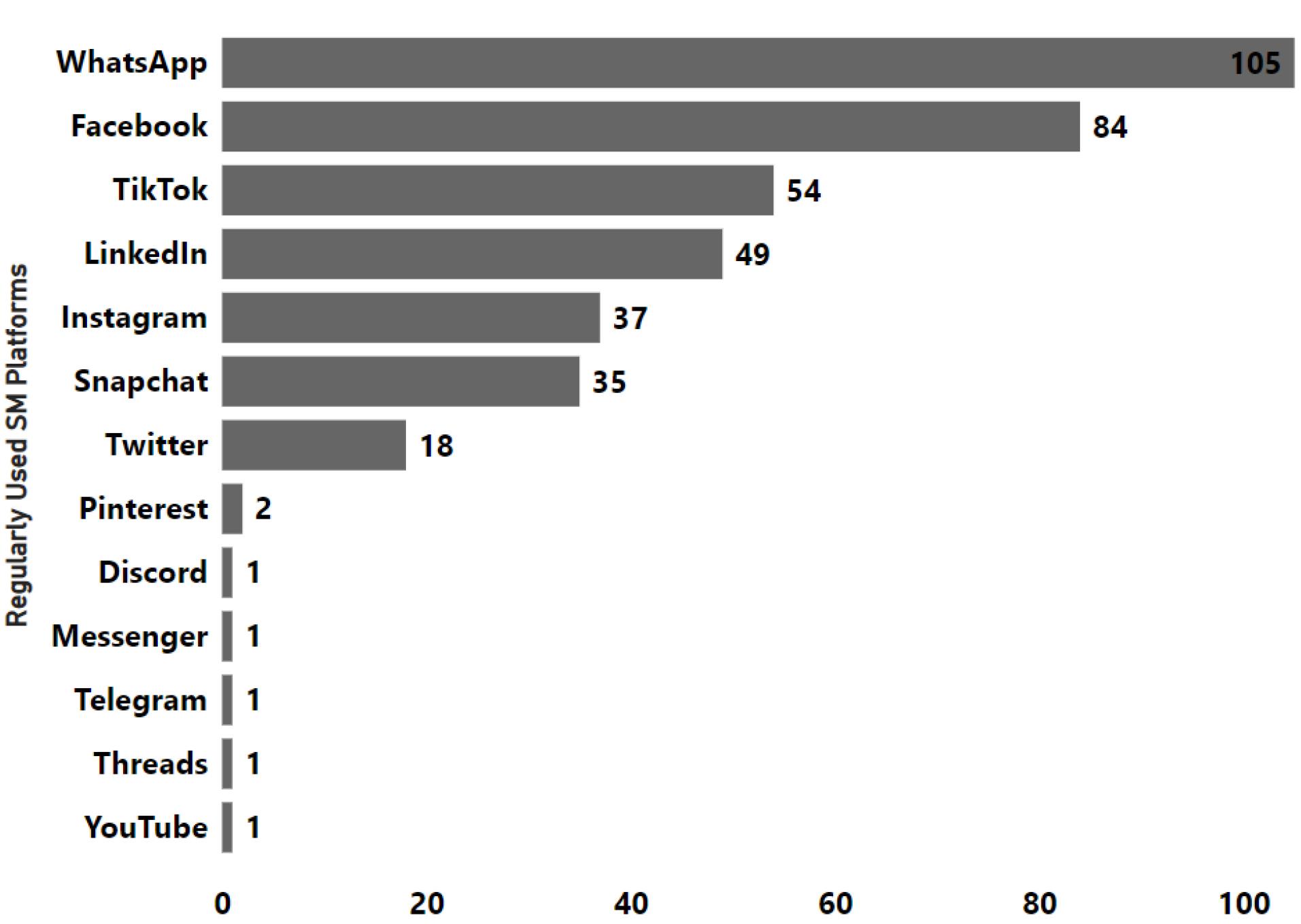
Figure 1.
Frequency of regular use across social media platforms
.
Frequency of regular use across social media platforms
Table 2.
Distribution of daily social media usage and health-related information sharing among participants
|
Variables
|
Categories
|
N
|
Percent
|
| Daily time spent on social media (h) |
>5 |
61 |
40.39 |
| 5 |
20 |
13.24 |
| 4 |
19 |
12.58 |
| 3 |
26 |
17.21 |
| 2 |
18 |
11.92 |
| 1 |
4 |
2.64 |
| <1 |
3 |
1.98 |
| Shared health-related information on social media |
Yes |
112 |
74.17 |
| No |
39 |
25.82 |
Impact of social media on health information-seeking behavior
The most frequently searched health topics on social media were infectious diseases (n = 76, 59.4%), sexual and reproductive health (n = 59, 46.1%), and exercise and fitness (n = 50, 39.1%), followed by infectious disease prevention (n = 46, 35.9%), chronic diseases (n = 44, 34.4%), first aid and emergency care (n = 43, 33.6%), and nutrition and diet (n = 43, 33.6%) (Figure 2). In terms of search frequency, the largest group of participants (n = 59, 39.07%) searched daily for health-related information, while 43 participants (28.47%) searched weekly, and 15 participants (9.93%) searched monthly. Additionally, 32 participants (21.19%) reported rarely searching for health-related information, and only 2 participants (1.32%) indicated never searching for such information (Table 3).
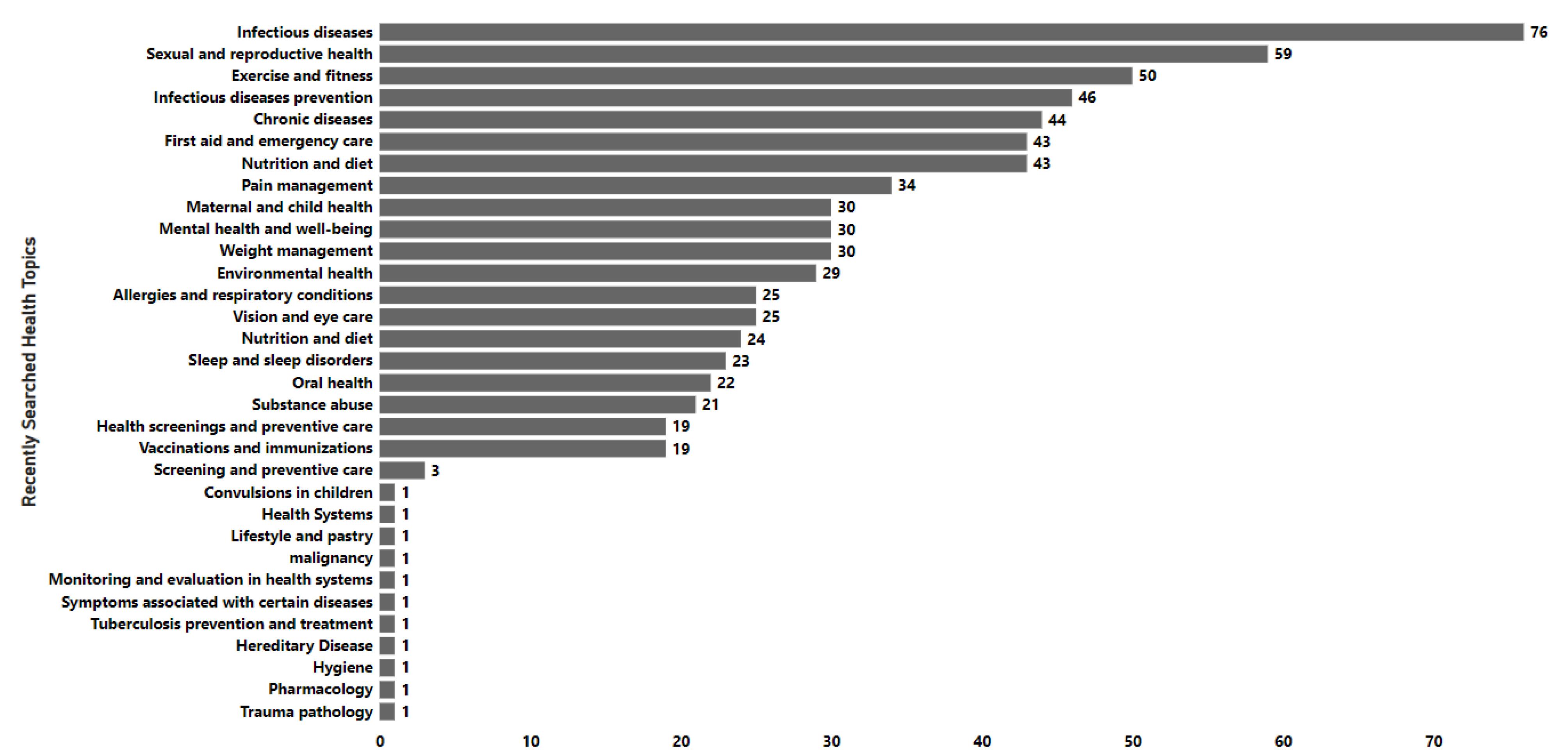
Figure 2.
Most frequently searched health-related topics on social media
.
Most frequently searched health-related topics on social media
Table 3.
Frequency of health-related information searches on social media
|
Variables
|
Categories
|
N
|
Percent
|
| Frequency of search for health-related information on social media |
Monthly |
15 |
9.93 |
| Weekly |
43 |
28.47 |
| Daily |
59 |
39.07 |
| Rarely |
32 |
21.19 |
| Never |
2 |
1.32 |
Cross-cultural variations in health information perception
The most cited influence on health information-seeking behavior was an emphasis on traditional remedies (n = 59, 58.4%), followed by respect for elders (n = 32, 31.7%), cultural stigma (n = 29, 28.7%), and religious beliefs (n = 26, 25.7%) (Figure 3). Trust in social media health information was primarily influenced by cultural values (n = 61, 51.3%), religious alignment (n = 34, 28.6%), and cultural sensitivity (n = 22, 18.5%). Smaller groups highlighted community endorsements (n = 21, 17.6%), while 11 participants (9.2%) noted no cultural impact (Figure 4).
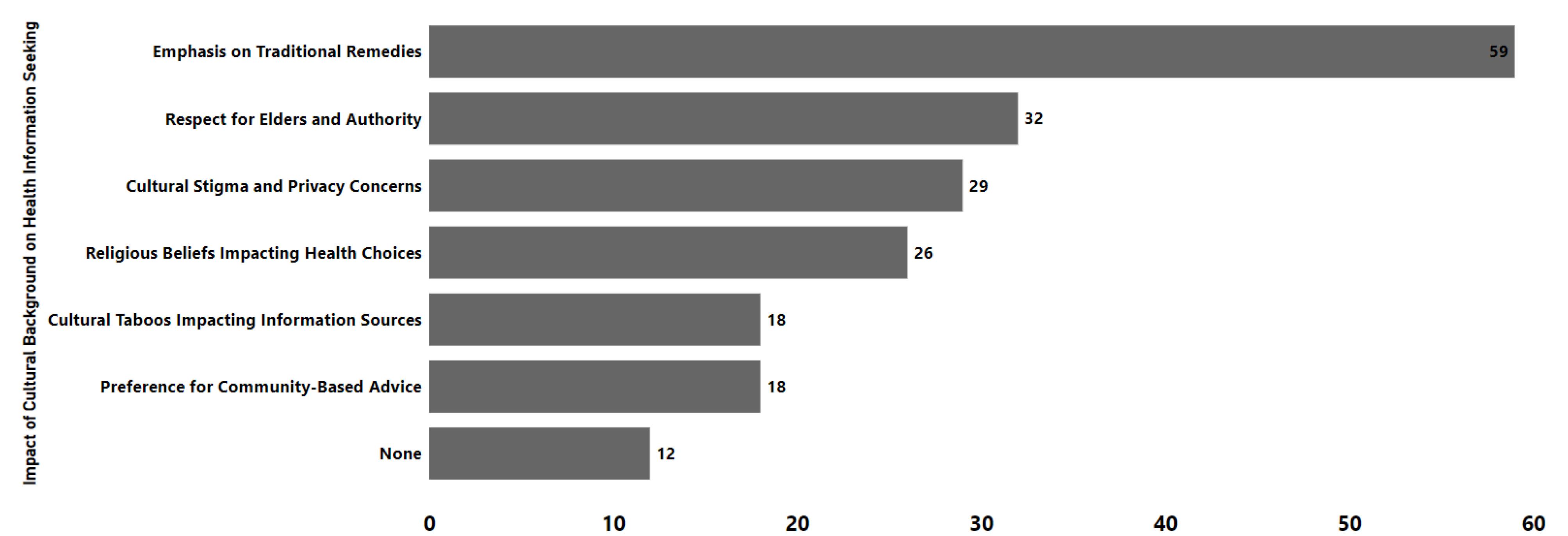
Figure 3.
Cultural factors influencing health information-seeking behavior on social media
.
Cultural factors influencing health information-seeking behavior on social media
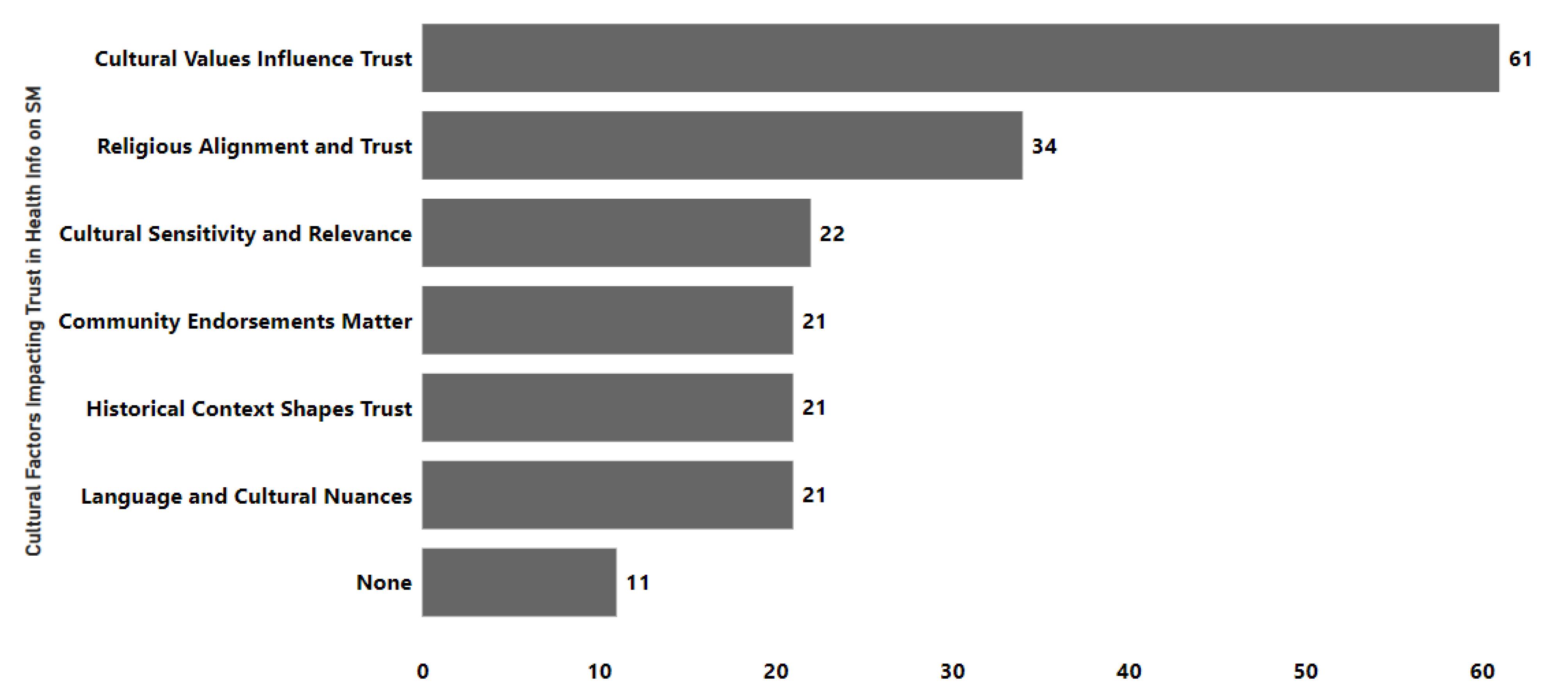
Figure 4.
Cultural factors influencing trust in health information on social media
.
Cultural factors influencing trust in health information on social media
Digital literacy
Confidence in evaluating the reliability of health information on social media varied among participants: 41 (27.2%) were very confident, 50 (33.1%) somewhat confident, and 45 (29.8%) neutral, while smaller groups reported low confidence (8, 5.3%, somewhat not confident; 7, 4.6%, not confident). Only 24.5% had received formal training in digital health literacy, with 75.5% lacking such training (Table 4). The most endorsed strategies to enhance cultural inclusivity in health campaigns were community involvement in planning (54.0%), respectful representation of cultural practices (44.5%), and cultural tailoring of content (43.1%), followed by collaboration with local influencers (38.7%) and use of traditional communication channels (37.2%) (Figure 5).
Table 4.
Confidence levels in assessing health information reliability on social media and formal training in digital health literacy
|
Variables
|
Categories
|
N
|
Percent
|
Confidence level in
discerning the reliability
of health-related
information on social
media |
Very confident |
41 |
27.15 |
| Somewhat confident |
50 |
33.11 |
| Neutral |
45 |
29.80 |
| Somewhat not confident |
8 |
5.29 |
| Not confident at all |
7 |
4.63 |
Received formal training
in digital health literacy |
Yes |
37 |
24.50 |
| No |
114 |
75.49 |
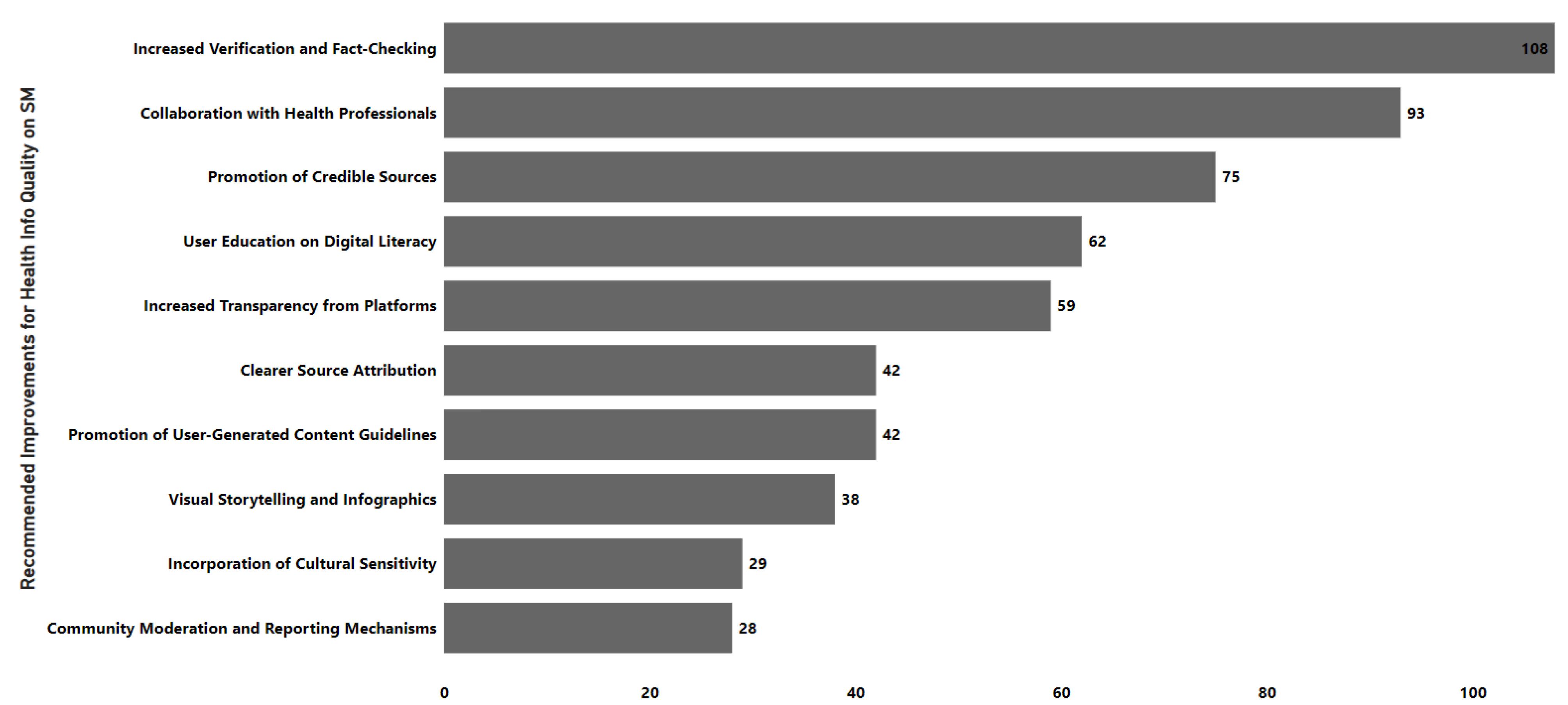
Figure 5.
Cultural factors influencing trust in health information on social media
.
Cultural factors influencing trust in health information on social media
Cultural background had statistically significant impact on health information-seeking behavior, influencing participants’ tendency to share health information, search frequency, and confidence in evaluating reliability, though it did not affect the specific topics searched. It also significantly influenced digital literacy, particularly confidence in assessing information reliability and formal education in digital health literacy (Table 5). These findings underscore the role of cultural factors in shaping how Cameroonian youth seek, assess, and trust health information on social media, highlighting the importance of culturally tailored approaches in health communication and digital literacy initiatives.
Table 5.
Regression analysis on the effect of cultural background (independent variable) on Health information-seeking behaviour and digital literacy
|
Variables
|
Categories
|
R2
|
P
value
|
| Health information seeking behaviour |
Shared health-related information |
0.01229 |
< 2.2e-16 |
| Frequency of seeking health information |
0.01162 |
< 2.2e-16 |
| Specific health topics searched |
-1.207e-06 |
0.6056 |
| Confidence in discerning reliable information |
0.2074 |
< 2.2e-16 |
| Digital literacy |
Confidence in evaluating info reliability |
0.0983 |
< 2.2e-16 |
| Formal education on digital health literacy |
0.02925 |
< 2.2e-16 |
Discussion
This study examines how cross-cultural factors, particularly involving social media, influence health information-seeking behavior among young adults in Cameroon. Social media platforms like Facebook and WhatsApp emerged as primary sources for health-related information, with cultural and religious values significantly shaping how individuals interpret and trust this information. These findings align with global research, such as studies in China, highlighting the critical role of digital literacy and cultural identity as moderators of health behaviors.20 The results underscore the importance of culturally sensitive health communication strategies tailored to local values and beliefs to enhance health literacy and information-seeking behaviors.8
Digital literacy significantly impacts health information behavior, necessitating tailored educational initiatives to improve young adults’ online health content assessment, a challenge faced in low- and middle-income countries.17 Studies from both high- and low-resource contexts have repeated the need for better digital health literacy, which these gaps imply may enable people to make educated health decisions.9,14
Furthermore, research has shown that social media can raise self-efficacy in health management by increasing online engagement with health content, which can boost confidence in making health-related decisions.16
The study reveals that social and cultural factors significantly influence self-efficacy in health management, with social media increasing confidence but also balancing traditional medicine values and community influence.24 Additionally, participants in this study were hesitant to trust social media sources, contrasting with Western cultures where digital platforms are often seen as trustworthy sources of health information, and similar sociocultural areas where misinformation concerns lead to high distrust.10 Resolving these issues through culturally relevant and locally relevant health initiatives that use traditional knowledge systems or community influencers (Figure 6) may boost confidence in online health information and promote its use in decision-making.22
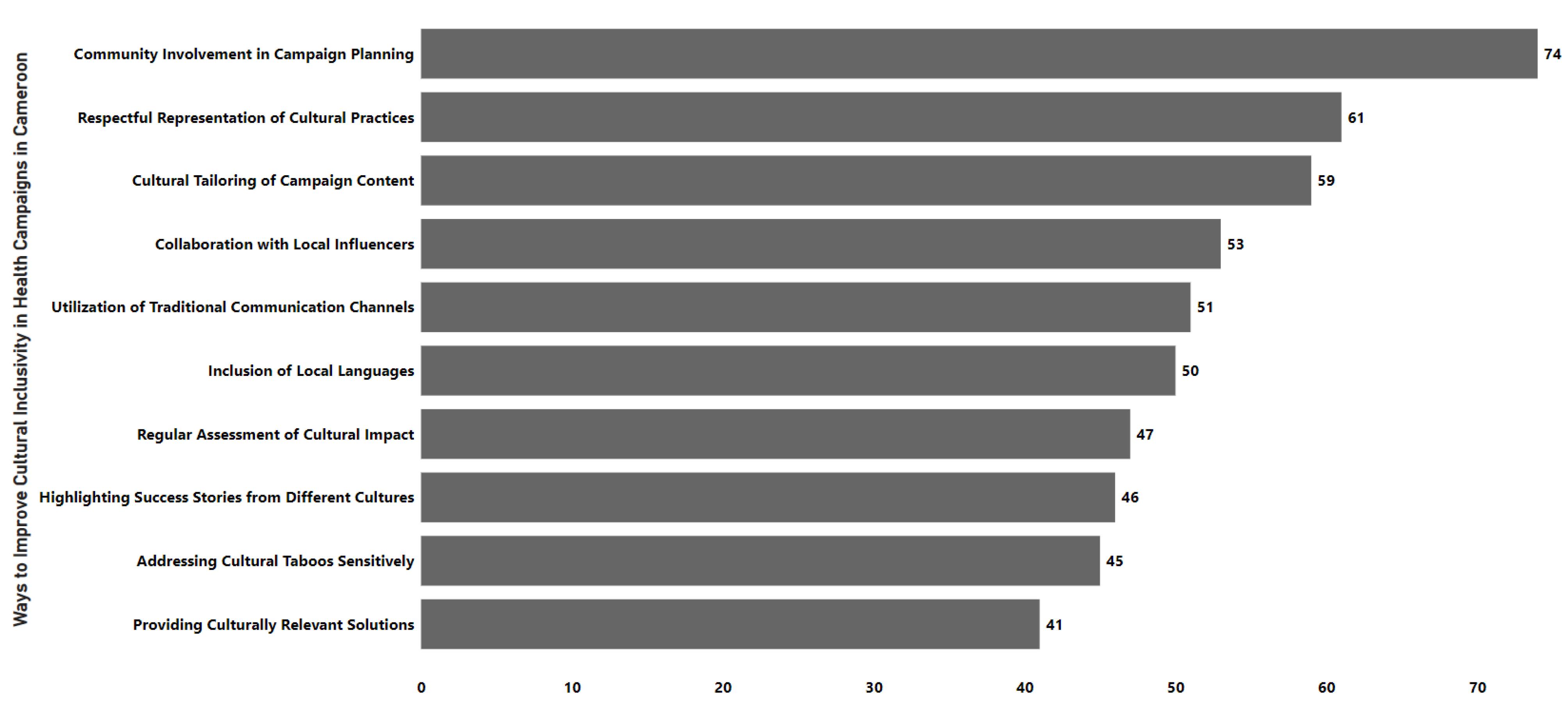
Figure 6.
Strategies for enhancing cultural inclusivity in health campaigns in Cameroon
.
Strategies for enhancing cultural inclusivity in health campaigns in Cameroon
Strengths and limitations
The study explores the cross-cultural dynamics influencing health information-seeking behavior on social media among young adults in Cameroon. Its diverse sample adds to the limited research on social media usage and health literacy in Sub-Saharan Africa. The study’s culturally focused analysis allows for a nuanced understanding of local values and beliefs shaping digital health behaviors, enabling culturally tailored health communication strategies. However, the cross-sectional design and self-reported data may introduce biases.
Conclusion, Implications, and Future Directions
The study highlights that cultural factors significantly impact young adults’ digital literacy and health information-seeking activities in Cameroon. It suggests that incorporating culturally relevant strategies into social media health promotion efforts can improve their effectiveness and address informational bias, mistrust, and gaps in digital health literacy. Health initiatives can increase trust and engagement with online health information by involving local community leaders and promoting health messages consistent with traditional values. The implications are significant for policymakers, healthcare providers, and educators in culturally diverse regions. Future research should explore the effects of digital health literacy training, linguistic and cultural backgrounds, and longitudinal designs to create more inclusive health communication strategies.
Competing Interests
The authors declare that they have no competing interests.
Ethical Approval
The research adhered to ethical protocols, providing participants with clear information about the study’s purpose, confidentiality measures, and withdrawal rights. Consent was implied upon survey completion, ensuring anonymity, data protection, and privacy. All participants engaged in the research voluntarily and anonymously. Their data are stored in coded materials and databases without personal data.
Acknowledgements
We want to sincerely thank all participants who contributed to this study. Your invaluable support and involvement made this research possible.
References
- Cotten SR, Gupta SS. Characteristics of online and offline health information seekers and factors that discriminate between them. Soc Sci Med 2004; 59(9):1795-806. doi: 10.1016/j.socscimed.2004.02.020 [Crossref] [ Google Scholar]
- Li Y, Wang X, Lin X, Hajli M. Seeking and sharing health information on social media: a net valence model and cross-cultural comparison. Technol Forecast Soc Change 2018; 126:28-40. doi: 10.1016/j.techfore.2016.07.021 [Crossref] [ Google Scholar]
- Niu Z, Willoughby J, Zhou R. Associations of health literacy, social media use, and self-efficacy with health information-seeking intentions among social media users in China: cross-sectional survey. J Med Internet Res 2021; 23(2):e19134. doi: 10.2196/19134 [Crossref] [ Google Scholar]
- Oh S, Syn SY. Motivations for sharing information and social support in social media: a comparative analysis of Facebook, Twitter, Delicious, YouTube, and Flickr. J Assoc Inf Sci Technol 2015; 66(10):2045-60. doi: 10.1002/asi.23320 [Crossref] [ Google Scholar]
- DataReportal – Global Digital Insights. Digital 2023: Cameroon. Available from: https://datareportal.com/reports/digital-2023-cameroon. Accessed March 22, 2024.
- Zhang L, Pentina I. Motivations and usage patterns of Weibo. Cyberpsychol Behav Soc Netw 2012; 15(6):312-7. doi: 10.1089/cyber.2011.0615 [Crossref] [ Google Scholar]
- Roberts M, Callahan L, O’Leary C. Social media: a path to health literacy. Inf Serv Use 2017; 37(2):177-87. doi: 10.3233/isu-170836 [Crossref] [ Google Scholar]
- Sørensen K, Van den Broucke S, Fullam J, Doyle G, Pelikan J, Slonska Z. Health literacy and public health: a systematic review and integration of definitions and models. BMC Public Health 2012; 12:80. doi: 10.1186/1471-2458-12-80 [Crossref] [ Google Scholar]
- Lambert SD, Loiselle CG. Health information seeking behavior. Qual Health Res 2007; 17(8):1006-19. doi: 10.1177/1049732307305199 [Crossref] [ Google Scholar]
- Verhoef LM, Van de Belt TH, Engelen LJ, Schoonhoven L, Kool RB. Social media and rating sites as tools to understanding quality of care: a scoping review. J Med Internet Res 2014; 16(2):e56. doi: 10.2196/jmir.3024 [Crossref] [ Google Scholar]
- Kamel Boulos MN, Wheeler S. The emerging Web 20 social software: an enabling suite of sociable technologies in health and health care education. Health Info Libr J 2007; 24(1):2-23. doi: 10.1111/j.1471-1842.2007.00701.x [Crossref] [ Google Scholar]
- Laranjo L, Arguel A, Neves AL, Gallagher AM, Kaplan R, Mortimer N. The influence of social networking sites on health behavior change: a systematic review and meta-analysis. J Am Med Inform Assoc 2015; 22(1):243-56. doi: 10.1136/amiajnl-2014-002841 [Crossref] [ Google Scholar]
- Schillinger D. Improving the quality of chronic disease management for populations with low functional health literacy: a call to action. Dis Manag 2001; 4(3):103-9. doi: 10.1089/10935070152596025 [Crossref] [ Google Scholar]
- Lee SY, Arozullah AM, Cho YI. Health literacy, social support, and health: a research agenda. Soc Sci Med 2004; 58(7):1309-21. doi: 10.1016/s0277-9536(03)00329-0 [Crossref] [ Google Scholar]
- Squiers L, Peinado S, Berkman N, Boudewyns V, McCormack L. The health literacy skills framework. J Health Commun 2012; 17 Suppl 3:30-54. doi: 10.1080/10810730.2012.713442 [Crossref] [ Google Scholar]
- Cao W, Zhang X, Xu K, Wang Y. Modeling online health information-seeking behavior in China: the roles of source characteristics, reward assessment, and internet self-efficacy. Health Commun 2016; 31(9):1105-14. doi: 10.1080/10410236.2015.1045236 [Crossref] [ Google Scholar]
- Deng Z, Liu S. Understanding consumer health information-seeking behavior from the perspective of the risk perception attitude framework and social support in mobile social media websites. Int J Med Inform 2017; 105:98-109. doi: 10.1016/j.ijmedinf.2017.05.014 [Crossref] [ Google Scholar]
- Lee SY, Hwang H, Hawkins R, Pingree S. Interplay of negative emotion and health self-efficacy on the use of health information and its outcomes. Communic Res 2008; 35(3):358-81. doi: 10.1177/0093650208315962 [Crossref] [ Google Scholar]
- Lee JY, Divaris K, Baker AD, Rozier RG, Vann WF Jr. The relationship of oral health literacy and self-efficacy with oral health status and dental neglect. Am J Public Health 2012; 102(5):923-9. doi: 10.2105/ajph.2011.300291 [Crossref] [ Google Scholar]
- Niu Z, Willoughby JF. Examining cultural identity and media use as predictors of intentions to seek mental health information among Chinese. Asian J Commun 2018; 28(4):360-76. doi: 10.1080/01292986.2018.1441319 [Crossref] [ Google Scholar]
- Niu Z, Willoughby JF, Mei J, Li S, Hu P. A cross-cultural comparison of an extended planned risk information seeking model on mental health among college students: cross-sectional study. J Med Internet Res 2020; 22(5):e15817. doi: 10.2196/15817 [Crossref] [ Google Scholar]
- Kushin MJ, Yamamoto M. Did social media really matter? College students’ use of online media and political decision making in the 2008 election. Mass Commun Soc 2010; 13(5):608-30. doi: 10.1080/15205436.2010.516863 [Crossref] [ Google Scholar]
- Jiang S, Street RL. Pathway linking internet health information seeking to better health: a moderated mediation study. Health Commun 2017; 32(8):1024-31. doi: 10.1080/10410236.2016.1196514 [Crossref] [ Google Scholar]
- Jiang S, Street RL. Pathway linking internet health information seeking to better health: a moderated mediation study. Health Commun 2017; 32(8):1024-31. doi: 10.1080/10410236.2016.1196514 [Crossref] [ Google Scholar]